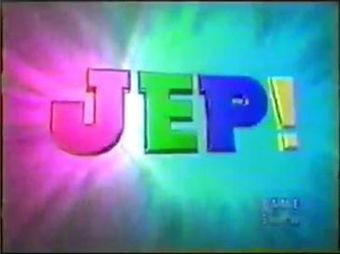Jep! facts for kids
Quick facts for kids Jep! |
|
|---|---|
 |
|
| Genre | Game show |
| Created by | Scott Sternberg |
| Based on | Jeopardy! Created by Merv Griffin |
| Directed by | Kevin McCarthy |
| Presented by | Bob Bergen |
| Theme music composer | Steve Kaplan |
| Country of origin | United States |
| Original language(s) | English |
| No. of seasons | 1 |
| No. of episodes | 22 |
| Production | |
| Executive producer(s) | Scott Sternberg, Harry Friedman |
| Producer(s) | Pamela Covais |
| Production location(s) | Sony Pictures Studios, Culver City, California |
| Running time | approx. 22 minutes |
| Production company(s) | Scott Sternberg Productions Columbia TriStar Television |
| Release | |
| Original network | Game Show Network |
| Picture format | Standard definition |
| Original release | January 30, 1998 – September 1, 2000 |
Jep! was an exciting American kids' TV game show. It was a special version of the famous quiz show Jeopardy!, made just for younger players. The show first appeared on the Game Show Network in 1998. Later, it was shown on Discovery Kids until 2004.
The host of Jep! was Bob Bergen, who is known for voicing Porky Pig. The show was created by Scott Sternberg. He also created Wheel 2000, which was a kids' version of Wheel of Fortune. Many people who worked on the regular Jeopardy! show also helped with Jep!. This included the director, Kevin McCarthy. Even Alex Trebek, the main Jeopardy! host, helped as a consultant for Jep!.
Contents
How to Play Jep! The Game Show for Kids
Who Can Play?
Kids aged 10 to 12 years old were the contestants on Jep!. The game was made a bit easier than the regular Jeopardy! show. This was similar to "Kids Weeks" that later appeared on the main Jeopardy! program.
Winning Prizes and Points
Instead of winning money, contestants on Jep! played for cool merchandise packages. The clue values were in points, not dollars. This is like some other Jeopardy! spin-offs, such as Sports Jeopardy!.
Game Rounds: Jep!, Hyper Jep!, and Super Jep!
The game had three rounds, just like regular Jeopardy!:
- The first round was called Jep! (like the Jeopardy! round).
- The second round was called Hyper Jep! (like Double Jeopardy!).
- The third and final round was called Super Jep! (like Final Jeopardy!).
Each round had five categories. Each category had four clues. The point values for clues were chosen randomly by pressing a button.
The "In Jeopardy!" Penalty System
Jep! had a fun penalty system! Each contestant's podium had three special "In Jeopardy!" lights.
- If a player gave a wrong answer, or didn't answer in the form of a question, points were taken away.
- Also, one of their "In Jeopardy!" lights would turn on.
- When the first light turned on, a "vat" above the player would start to fill with toys like plastic frogs or balls.
- If a second light turned on, the vat would tip over! All the toys would spill onto the contestant.
- If the third light turned on, the contestant's chair would slide back behind a wall. This meant they were out of play for one clue.
Playing Super Jep!
Unlike the main Jeopardy! show, everyone got to play "Super Jep!". If a player had zero or a negative score after "Hyper Jep!", their score was automatically raised to 500 points. To keep the game fair, the amount needed to raise that player's score was then added to the other players' scores. This made sure the differences between scores stayed the same.
Special Clues and Features
- Jep! Prize: Besides the usual Daily Doubles, Jep! also had a "Jep! Prize" clue. If a contestant answered this clue correctly, they would win a special prize, like a Game.com handheld console.
- Jep! Squad: The show also featured the "Jep! Squad." This was a group of kids from different parts of America. They acted like reporters, delivering video clues to the contestants. This was similar to the "Clue Crew" that later appeared on the main Jeopardy! show.
Final Prizes
At the end of the game, all three players got to choose from two prizes. The value of the prizes increased depending on whether the player finished in third, second, or first place.

